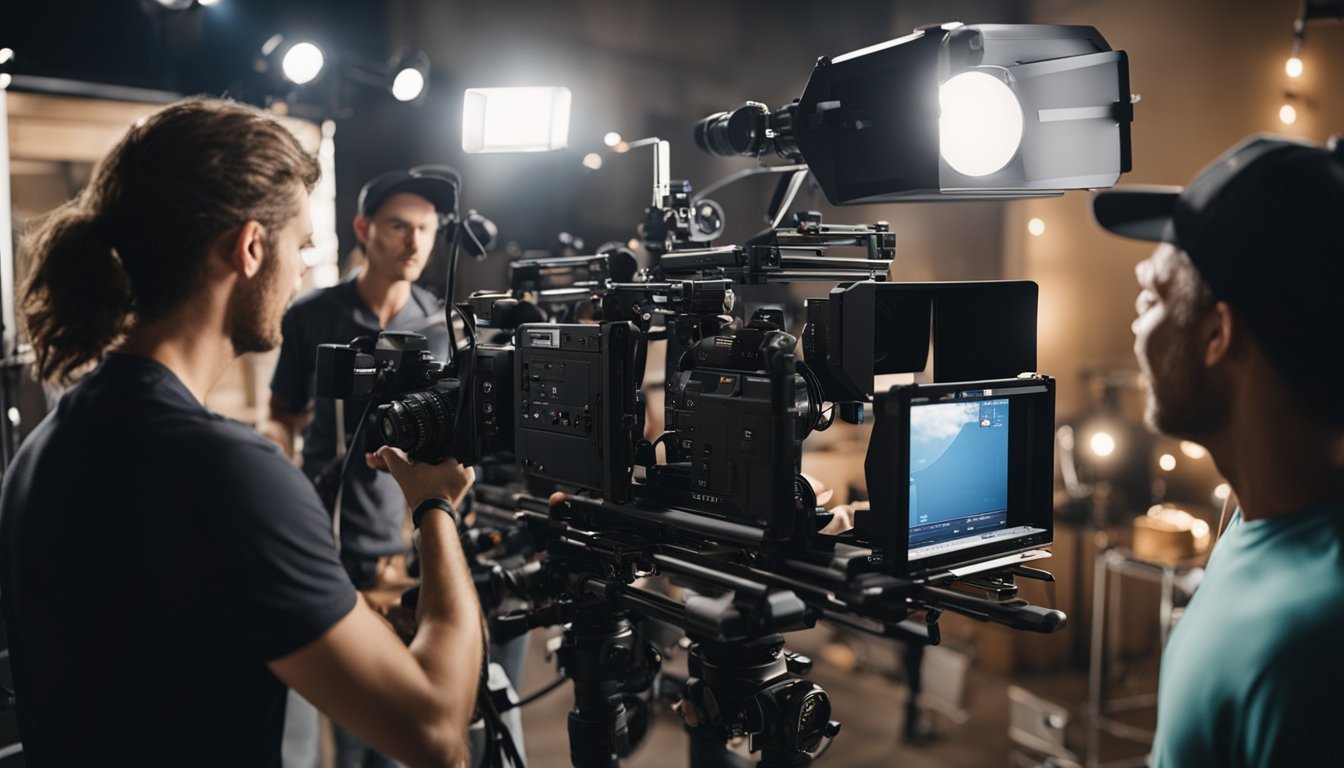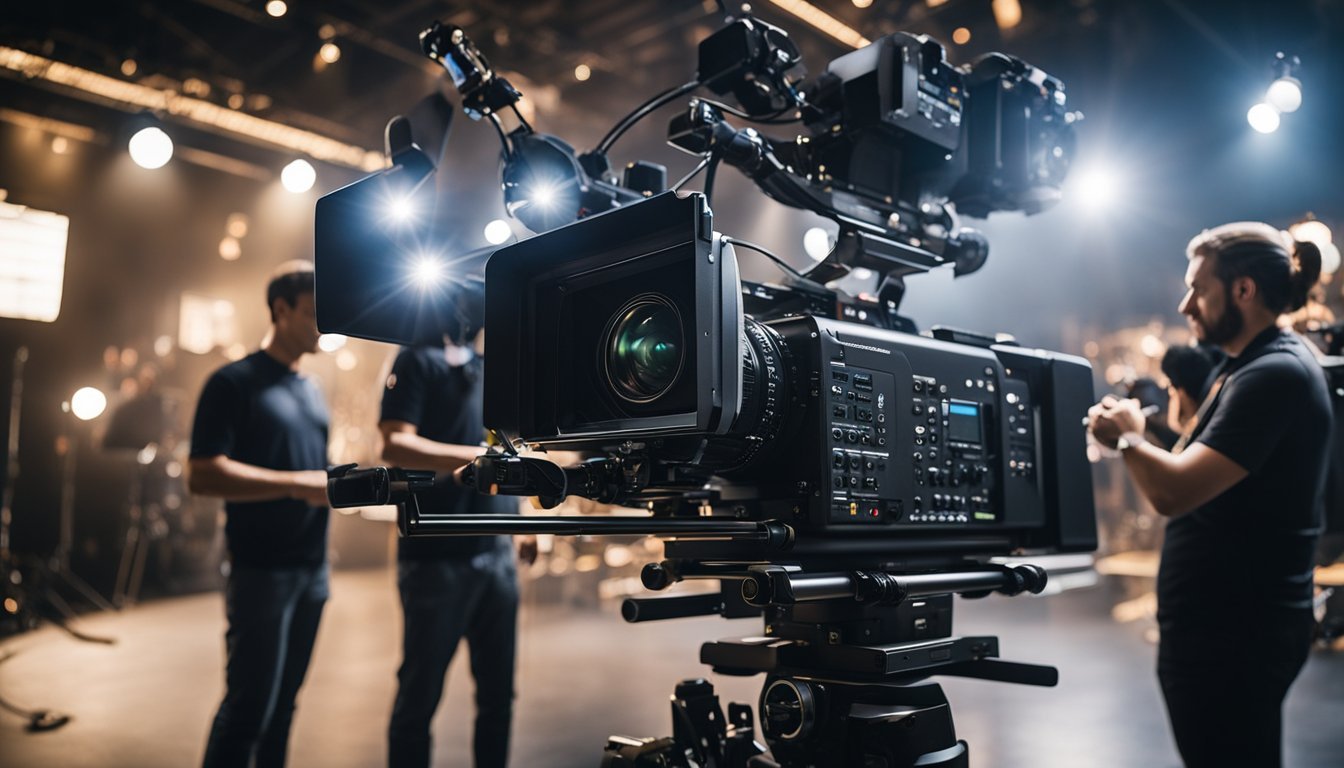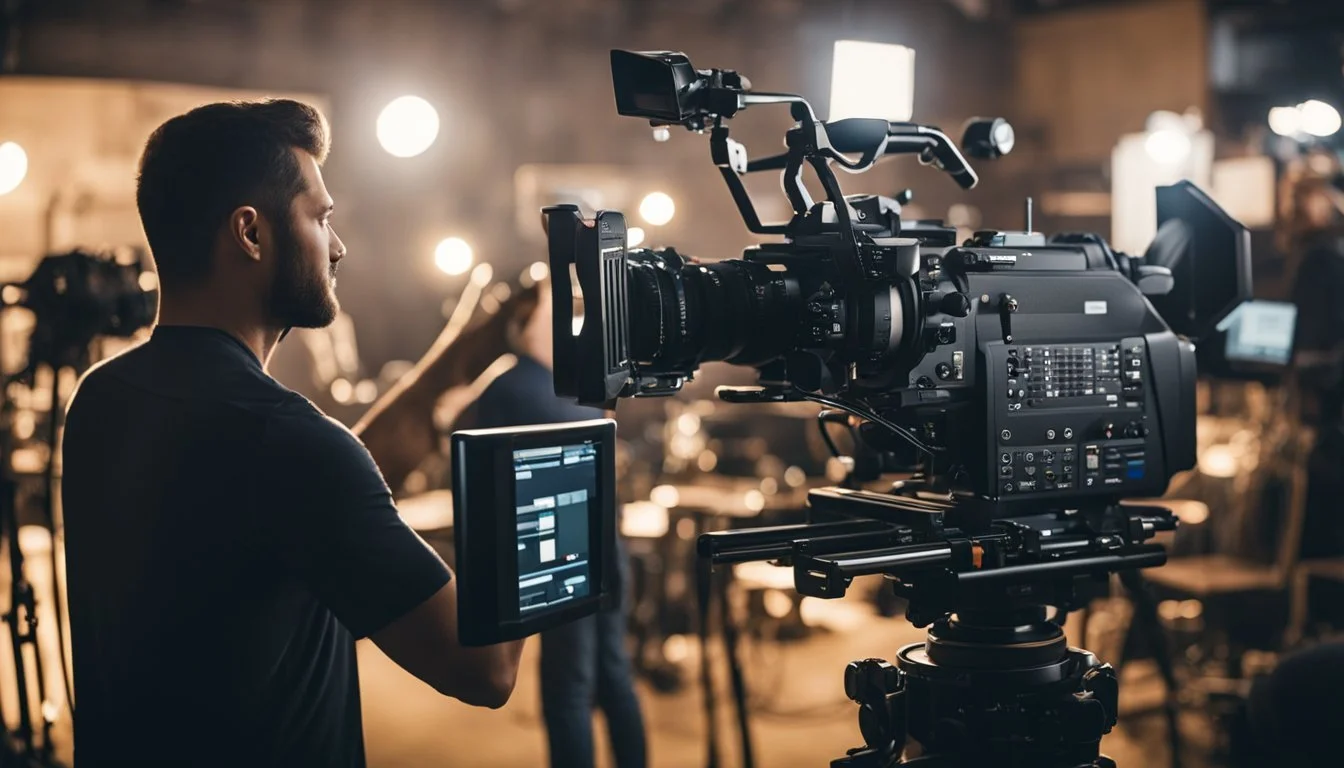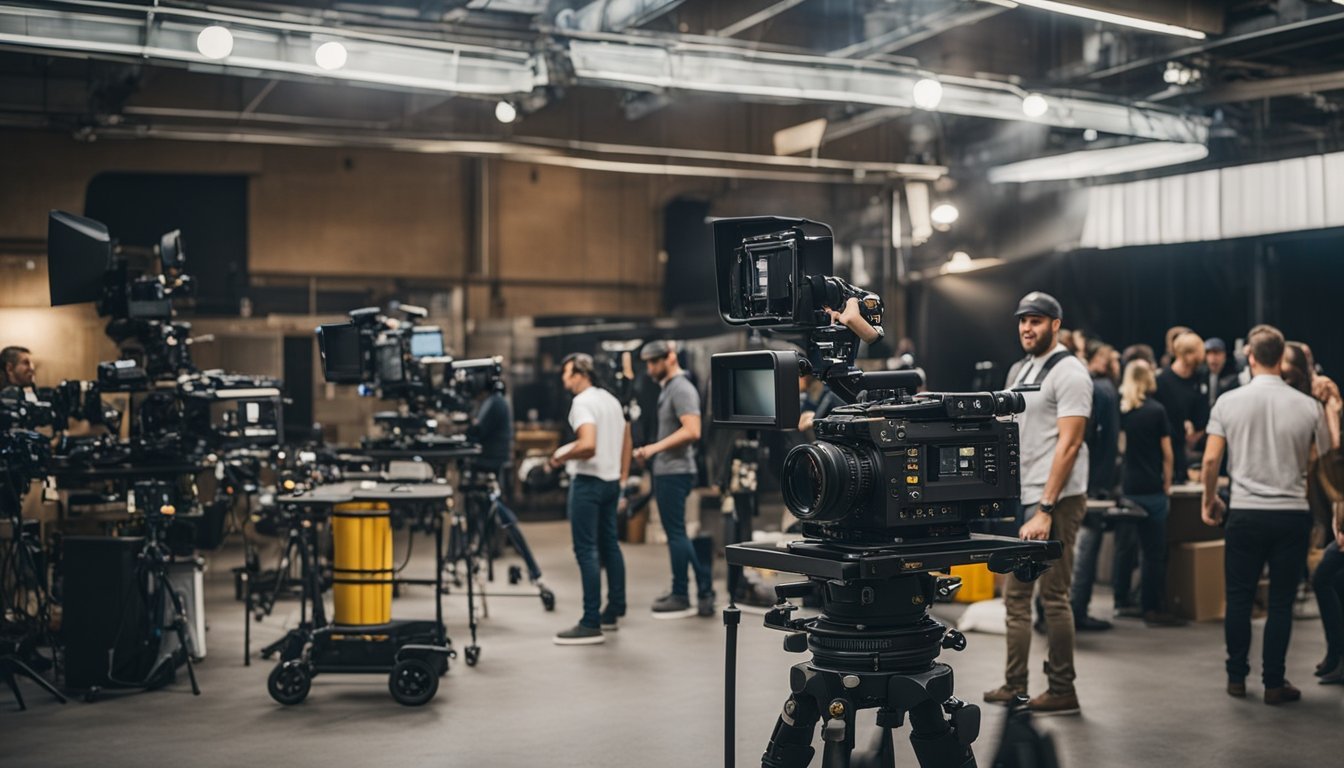19 Essential Film Crew Roles and Responsibilities
Understanding Key Positions on Set
Understanding the various roles within a film crew is essential for anyone interested in the film industry. Each position plays a critical part in the creation of a film, from pre-production to post-production. By examining the 19 essential film crew roles and responsibilities, one can gain a comprehensive view of how a film project is brought to life.
Identifying the key responsibilities and duties of these film crew roles provides valuable insight into the collaborative effort required to produce a successful movie. This knowledge not only helps aspiring filmmakers but also offers a deeper appreciation for the teamwork and dedication involved in film production.
1) Director
The director is the creative force behind a film. They are responsible for translating the screenplay into a compelling visual story. This involves working closely with actors, guiding their performances, and ensuring that their portrayals align with the overall vision of the film.
Directors also collaborate with various crew members, including the cinematographer, production designer, and editor. They make critical decisions regarding the film's visual style, pacing, and tone. This collaboration ensures that every element of the production contributes to the storytelling.
During filming, directors oversee the shooting process, making adjustments to scenes and shots as needed. They ensure that the production is on schedule and stays within budget. Directors also play a key role in post-production, working with editors to shape the final cut of the film.
2) Producer
The producer is a cornerstone of film production, responsible for the project's inception through to its completion.
They secure financing for the film, whether through investors, studios, or alternative means.
Budget management falls within their purview, ensuring the project adheres to financial constraints.
Hiring is another critical task, involving the selection of key roles such as the director, cinematographer, and editor.
Producers oversee the production schedule, ensuring milestones are met and addressing issues promptly.
They often liaise between the creative and financial sides, balancing artistic vision with fiscal responsibility.
Throughout the filming process, the producer maintains a close watch on production dynamics, adapting as necessary to keep the project on track.
3) Screenwriter
The screenwriter is the creator of the film's script.
They are responsible for crafting the story, characters, dialogue, and overall structure. This involves transforming a concept into a script that serves as the blueprint for the entire production.
Screenwriters write for various visual mediums such as feature films, short films, television, commercials, and video games. Their role demands creativity and a deep understanding of storytelling conventions. They must adapt to the needs of different genres and formats.
Research is a crucial part of their job. To ensure authenticity, screenwriters often become experts on topics relevant to their stories. Many start their careers writing scripts "on spec," or speculation, before securing freelance or contracted work.
4) Cinematographer
The cinematographer, also known as the Director of Photography (DoP or DP), is crucial in shaping the visual narrative of a film. They collaborate closely with the director to translate the story into visual images.
They are responsible for selecting camera equipment, lenses, and filters. This role involves planning and overseeing all camera movements and angles during filming.
Lighting is another key aspect managed by the cinematographer. They determine the lighting setup to enhance the mood and atmosphere of scenes.
Additionally, the cinematographer works with the production design team to ensure visual consistency. They play a pivotal role in color grading and post-production to maintain the desired look of the film.
Their expertise in framing, composition, and visual storytelling contributes significantly to the film’s artistic vision.
5) Editor
The film editor plays a crucial role in shaping the final narrative of a movie.
They are responsible for assembling the raw footage into a coherent and engaging storyline. This process is essential in ensuring that the director’s vision is accurately portrayed on screen.
Editors work closely with the director during post-production. They select the best takes, trim scenes, and adjust the pacing of the film. Their goal is to create a seamless and captivating flow that enhances the story.
Many editors also begin their work during production. They often start assembling scenes and sequences as the filming progresses. This early involvement helps in identifying any potential problems or gaps that might need additional footage.
Additionally, editors collaborate with sound designers and music composers. The integration of sound and music is a vital aspect of their work, contributing significantly to the film's emotional impact and overall atmosphere.
The role requires a keen eye for detail and a deep understanding of storytelling. Successful editors often have a strong sense of timing, rhythm, and visual aesthetics. Their skill in crafting the final cut makes them pivotal to the filmmaking process.
6) Production Designer
The production designer plays a crucial role in the creation of a film’s visual identity. They collaborate closely with the director and art director to shape the film’s sets and locations. By overseeing the design and aesthetic aspects, they ensure that every element aligns with the director’s vision.
A production designer is responsible for translating the script into a physical, visual world. They work with a team that includes set dressers, propmasters, and construction crews. The goal is to turn written descriptions into tangible sets and scenes.
Meetings and revisions are a regular part of a production designer’s job. They must obtain approvals from the director, producers, and occasionally the writers. This iterative process helps to refine the look and tone of the film.
Cost management is another key responsibility. The production designer works within a budget, making it essential to balance creativity with financial constraints. They source materials, design sets, and manage the construction process.
In smaller productions, the roles of production designer and art director may be combined into a single position. This streamlined approach helps maintain coherence in design choices while minimizing costs.
Ultimately, the production designer contributes significantly to the audience’s immersion, crafting environments that support storytelling and character development.
7) Costume Designer
A costume designer is an integral part of the film production team. They are responsible for designing the clothing and accessories worn by actors. This role demands a combination of artistry, research, and practical skills.
Costume designers collaborate closely with the director to understand the visual narrative and the time period of the story. They ensure that the costumes align with the director’s vision and the overall aesthetic of the film.
In addition to design, costume designers handle the selection of fabrics, colors, and accessories. They also manage the budgeting and purchasing of materials. Their work requires careful attention to detail to maintain consistency and authenticity.
Communication with actors is also crucial. Designers must ensure that the costumes are comfortable and fit well, enabling actors to move freely and perform effectively. In this way, costume designers significantly contribute to character development and storytelling.
8) Sound Designer
A Sound Designer is a pivotal member of the film crew, responsible for crafting the sonic elements that enrich a film's narrative. They work closely with the director to translate the creative vision into an auditory experience.
Sound Designers begin by analyzing the script and identifying key moments that require specific sounds. They record original sound effects, capturing everything from subtle ambient noises to dramatic audio elements.
Layering and synthesizing sounds is another critical aspect of their role. By blending various audio tracks, they create complex soundscapes that enhance the emotional impact of scenes.
In addition to sound effects, they also handle dialogue clarity. This involves ensuring that every line of dialogue is crisp and intelligible while balancing it with background noises and music.
Their work continues through post-production, where they mix and edit audio to achieve the final sound mix. This step is crucial for integrating audio seamlessly with the film's visuals, creating an immersive experience for the audience.
9) Gaffer
The gaffer is the head of the electrical department on a film set. This role is vital for managing all lighting needs during production. They collaborate closely with the Director of Photography (DP) to implement the desired lighting design.
Their responsibilities include setting up and adjusting lighting equipment. They ensure that lighting setups adhere to the creative vision while maintaining safety standards.
The gaffer supervises the lighting crew, often directing their team to handle technical setups and adjustments. Their expertise in lighting design is crucial for achieving the visual style of the film.
Efficient communication with other departments is key for the gaffer. They must coordinate with production designers and camera operators to ensure cohesive results.
In addition to artistic duties, a gaffer manages the practical aspects of lighting. This includes budgeting, scheduling, and resource management to ensure everything runs smoothly.
The skillset required for a gaffer encompasses both technical proficiency and creative understanding. They must adapt quickly to changes on set, providing solutions that align with the director's vision.
10) Grip
A Grip plays a crucial role on a film set, primarily working with the camera and lighting departments. They set up, rig, and strike lighting equipment, ensuring that all gear is securely and efficiently positioned.
Key Grips lead the Grip team, coordinating tasks and ensuring that everything runs smoothly. Dolly Grips specifically handle moving the camera dolly, working closely with Camera Operators.
Grips also provide support for camera rigs, scaffolding, and other essential apparatus. Their expertise ensures that cameras remain stable, allowing for smooth and precise shots. They often collaborate with the Director of Photography to execute the visual vision of the project.
In addition to their technical tasks, Grips are responsible for equipment maintenance and organization. They ensure that all tools and gear are in top condition and readily accessible. This meticulous attention to detail keeps the production running efficiently and safely.
11) Key Grip
The Key Grip plays a vital role in the film production process, working closely with the Director of Photography (DoP) and the Gaffer.
They oversee the grip department, which manages all rigging and camera support equipment.
Responsible for the safe setup of camera rigs, dollies, cranes, and other mounts, their expertise ensures the stability and precision needed for specific shots.
Key Grips inventory and maintain grip equipment throughout the shoot, ensuring everything is accounted for and in working order.
They also supervise and assign tasks to other grips, coordinating efforts to meet the production's requirements.
Collaborating with the Gaffer, Key Grips help shape the lighting by setting up rigs and structures where lights are mounted.
12) Art Director
The Art Director is a critical role in film production, responsible for the film's visual aesthetic. They work closely with the Production Designer to develop and implement the design vision.
They oversee the construction and decoration of sets. This includes sourcing materials, coordinating with set designers, and ensuring all visual elements align with the director’s vision.
In addition, they manage the props, scenic art, and set design departments. They ensure that all departments collaborate effectively and stay within budget constraints.
Art Directors are present on set to maintain the visual consistency of the film. They address any design issues that arise during filming, maintaining the integrity of the aesthetic vision.
13) Makeup Artist
A makeup artist plays a crucial role in the film industry, transforming actors into their characters. They ensure that makeup aligns with the era, setting, and storyline of the film.
Makeup artists collaborate closely with directors and costume designers to create cohesive looks.
Their work includes applying basic makeup, prosthetics, and special effects makeup.
On set, makeup artists are responsible for touch-ups throughout the shooting day to maintain continuity. They must be skilled in various techniques, from natural looks to elaborate transformations. They also account for how makeup appears under different lighting and camera conditions.
They often work long hours and need to adapt quickly to production changes. Attention to detail and creativity are essential traits for this role. Their work ensures that actors' appearances contribute effectively to the storytelling of the film.
14) Hair Stylist
A hair stylist in film plays a pivotal role in character development. They create and maintain hairstyles that reflect the character's era, culture, and personality. This visual storytelling technique helps the audience instantly understand the genre and tone of the film.
The role involves close collaboration with the director, costume designer, and makeup artist. This ensures a cohesive look for each character that aligns with the film's vision. Hair stylists may also need to adapt quickly to changes in script or character design.
Attention to detail is crucial. Hairstyles must remain consistent between scenes, which can be challenging during long shooting schedules. The stylist's work impacts continuity, making their role essential in maintaining the film's visual integrity.
The work can range from simple styles to complex, iconic looks. For example, think of Princess Leia's buns or Dorothy's pigtails. Each hairstyle becomes a memorable element that supports the narrative and adds depth to the character.
Film hair stylists bring technical skill and creativity to the set. Their expertise enhances the story, making them indispensable to the film crew.
15) Set Decorator
A Set Decorator plays a vital role in the visual storytelling of a film. Responsible for decorating the film set, they select, design, and source furniture, drapery, lighting fixtures, and artwork.
They work closely with the Production Designer to create a cohesive look that aligns with the director's vision. Their work ensures that each set looks authentic and immerses the audience in the film's world.
In addition to the visual elements, they manage the logistical aspects of sourcing and arranging set pieces. This involves coordinating with suppliers and managing a team to ensure everything is in place on shoot days.
It’s a freelance role, allowing them to work on various projects, from films to TV shows and stage productions. The Set Decorator's work is essential for adding depth to the story, creating a captivating environment for the actors and the audience.
16) Script Supervisor
The script supervisor holds a crucial role in the film production team. This individual ensures that continuity is maintained throughout the filming process. They meticulously monitor each scene, noting details such as dialogue, actions, and timing.
Working closely with the director, the script supervisor helps to ensure the visual narrative remains coherent. They take detailed notes on any changes or discrepancies that occur during shooting.
This role requires a keen attention to detail, as the script supervisor keeps track of various elements like costumes, props, and set decorations. They ensure that these elements are consistent across different takes and scenes.
The script supervisor also liaises with other departments, including makeup and hair, to maintain continuity. Their input is invaluable in the editing room, as they provide detailed reports that help editors piece the film together seamlessly.
Overall, the script supervisor's role is indispensable in creating a polished and professional final product. Whether tracking character movements or monitoring dialogue, their ability to catch and rectify errors in real-time is essential for the continuity and quality of the film.
17) Casting Director
The Casting Director is pivotal in the film production process. They are responsible for finding the right actors to bring the characters of the script to life.
Working closely with the director and producers, the Casting Director understands the vision for the film and identifies the best talent that matches the character descriptions.
The Casting Director organizes auditions, reviews performance tapes, and conducts callbacks to ensure the selected actors fit both the role and the overall ensemble cast.
They negotiate contracts and work out availability to align with the shooting schedule. This role requires a deep understanding of acting talent and a keen eye for potential.
18) Assistant Director
The Assistant Director (AD) plays a crucial role on the set of a film or TV production. They act as the right hand to the director, ensuring that the director's vision is efficiently executed.
The AD is responsible for creating and managing the shooting schedule. This involves coordinating with all department heads to ensure that everything runs smoothly. Their organizational skills ensure that each day’s tasks are carried out seamlessly.
Communication is a key aspect of the AD's role. They serve as the liaison between the director and the rest of the crew, making sure that everyone is on the same page. This helps in avoiding any misunderstandings and keeps the production on track.
Managing the logistics of the set is another critical duty. The AD oversees the movement of people and equipment, ensuring that everything is in the right place at the right time. This role demands a high level of multitasking and problem-solving skills.
Safety on set is also one of the AD’s responsibilities. They ensure that all safety protocols are followed, creating a secure working environment for the cast and crew. Their vigilance helps in preventing accidents or delays.
19) Location Manager
A Location Manager plays a pivotal role in the film production process. They are responsible for finding and securing filming locations that match the director’s vision. This involves not only the creative aspect but also handling logistical challenges.
They work closely with the director and production designer to ensure that each location fits the aesthetic needs of the film. Once locations are identified, the Location Manager negotiates contracts and secures necessary permits with property owners.
In addition, they coordinate schedules, ensuring that the crew knows where and when to be on set. They manage daily logistics and troubleshoot any location-related issues that arise during filming.
Their organizational skills are vital, as they must keep detailed records of locations and manage the budget allocated for site procurement. They also ensure that filming activities comply with local regulations and maintain a positive relationship with the community surrounding the filming sites.
The job demands excellent communication skills, extensive research capabilities, and a keen eye for detail. The Location Manager’s contributions are crucial for ensuring that the filming process runs smoothly and that each scene is shot in the perfect setting.
Understanding Film Crew Dynamics
Film crew dynamics hinge on efficient collaboration and clear hierarchy. These factors are critical in ensuring seamless production and effective execution of a film project.
Collaboration and Communication
Effective collaboration within a film crew is paramount. Each member relies on others to fulfill their specific roles, from the director's vision to the cinematographer's execution.
Communication is vital, facilitated through daily meetings, walkie-talkies, and digital tools. Clear instructions, timely feedback, and openness to suggestions create a productive environment.
Film crews often use call sheets, which outline daily schedules and assignments. This helps in synchronizing activities across various departments, ensuring everyone stays informed and aligned.
Hierarchy and Leadership
A film crew's hierarchical structure clarifies roles and responsibilities. At the top are the producer and director, who make overarching decisions. Below them, department heads like the cinematographer and production designer manage their teams.
Leadership is key to maintaining order and efficiency. Directors guide creative aspects, while producers oversee logistical and financial elements. Department heads act as intermediaries, ensuring their team's tasks align with the film's goals.
This structure fosters accountability and streamlines decision-making, essential for handling complex projects with numerous moving parts.
The Director’s Vision
The director plays a critical role in shaping the final product of a film. They are responsible for interpreting the script and directing actors to bring the story to life.
Interpreting the Script
The director closely analyzes the script to understand the story's emotional and narrative arc. They identify the themes, character motivations, and visual style that will best convey the writer's intentions. This involves deciding on the film’s tone, pacing, and overall aesthetic.
Collaborating with the screenwriter, the director may suggest changes or enhancements to the script to ensure it aligns with their vision. They also work with the cinematographer to plan the visual composition of each scene. This includes selecting camera angles, lighting, and shot types to effectively tell the story.
Directing Actors
Directing actors is a primary responsibility of the director. They guide performances to ensure that each actor understands their character’s motivations and relationships. The director provides feedback and direction during rehearsals and takes, helping actors deliver consistent and believable performances.
Establishing a trusting environment is crucial, as actors need to feel comfortable exploring their characters. The director often collaborates with the actors on interpreting scenes and may offer specific techniques or insights to elicit the desired emotions and reactions. The goal is to create authentic and compelling portrayals that align with the film's narrative.







